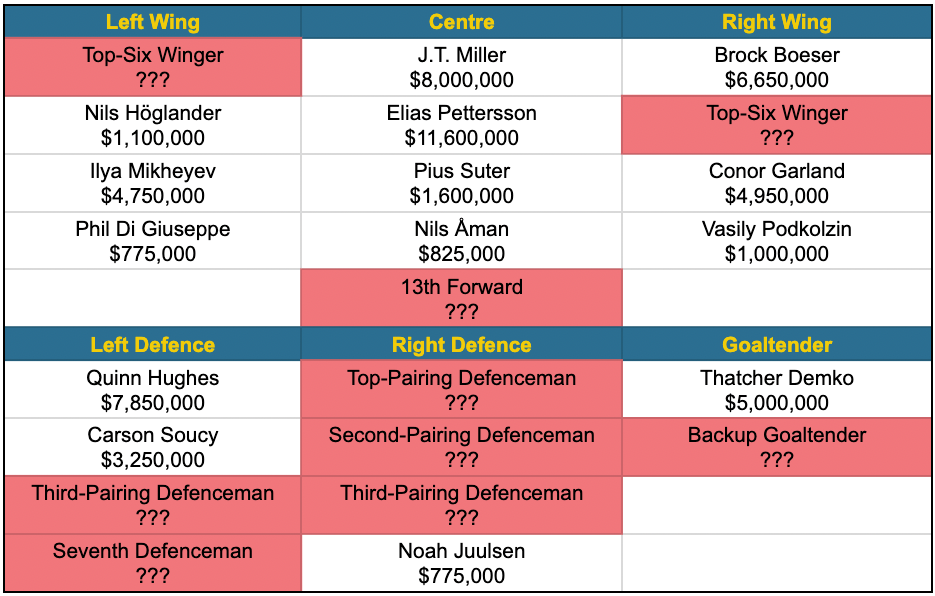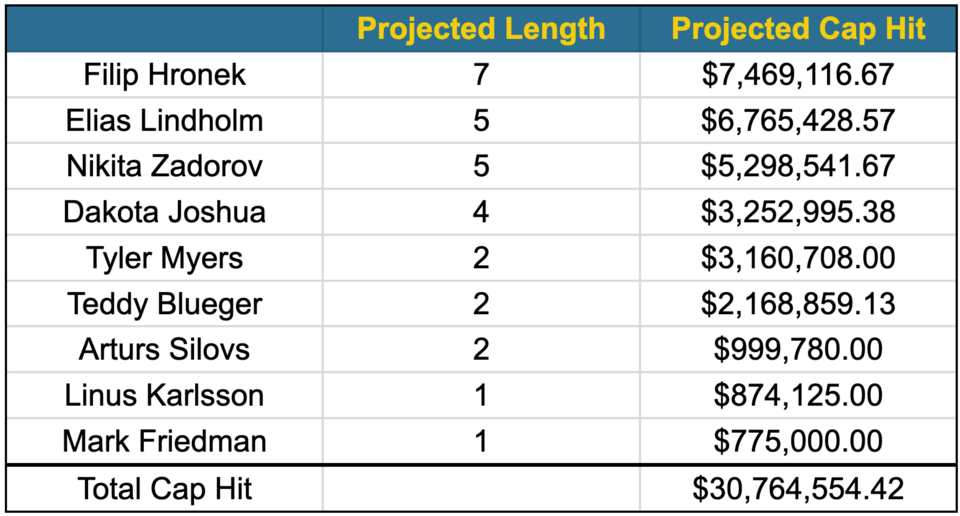The Vancouver Canucks paid a hefty price to get Elias Lindholm from the Calgary Flames. How hefty will the price be to keep him in Vancouver?
The Canucks want to keep Lindholm, from management on down to the players. General manager Patrik Allvin emphasized the importance of “strength in the middle” at the team’s end-of-year media availability, which is what led him to acquire Lindholm in the first place.
Meanwhile, the players themselves have reportedly made a push to bring Lindholm back. They were even willing to joke about it when Lindholm was asked about what it will take for him to re-sign with the Canucks.
“Be really specific,” quipped Thatcher Demko on one side of Lindholm, while J.T. Miller jokingly urged him to name “years and salary” on the other.
Sportsnet’s Elliotte Friedman believes the Canucks have a number in mind for both years and salary.
“The recruiting efforts from the Canucks players were pretty intense: ‘You’ve gotta stay, you’ve gotta stay, you’ve gotta find a way to stay.’ I still think that that’s going on,” said Friedman. “This is my guess, okay? I think the Canucks are willing to go in the seven times seven range. I’m just not sure it’s going to get it done. I think the Canucks want this player.”
If it’s a guess, call it an educated one given Friedman’s sources: seven years at $7 million per year.
That’s certainly not cheap but neither is it wildly expensive for a player who has consistently played first-line minutes over the last six seasons. It also might not be enough to entice Lindholm away from testing free agency, where he’ll be one of the biggest names available.
The question is, can the Canucks even afford to pay Lindholm $7 million per year? Should they sign a 29-year-old forward whose points have declined significantly over the last two seasons to a seven-year deal? That's a contract that could prove problematic a few years down the line depending on how Lindholm ages but can they even afford it for next season?
The Canucks' salary cap situation heading into the 2024 offseason
Let’s take a look at the big picture for the Canucks: who do they have signed for next season, where are there still gaps in their roster, and how much money do they have to spend?
“The main challenge is to fit 23 players on the roster. That’s always the biggest challenge,” said Allvin. “That’s where our job here is to build the roster and the lineup and see what areas that we’re willing now to put some younger players in or by allocating money.”
Here’s where the Canucks currently stand with 14 players presumed to be on their NHL roster, with the gaps that need to be filled highlighted in red.

Along with Oliver Ekman-Larsson’s $2,346,667 cap hit from his buyout, this lineup, which is nine players short of a full 23-man roster, leaves the Canucks with $27,228,333 remaining in cap space.
There are some significant missing pieces, including two top-six forwards — maybe three, depending on how you feel about Nils Höglander — and four everyday defencemen, including the entire right side, depending on how you feel about Noah Juulsen.
Re-signing free agents would send Canucks over the salary cap
Of course, the Canucks have plenty of pending restricted and unrestricted free agents who could potentially fill those gaps. But they can’t, or won’t, re-sign all of them.
Reports have already come out suggesting the Canucks won’t be re-signing Ian Cole or Casey DeSmith and it seems unlikely they’ll re-sign Sam Lafferty.
Here are nine free agents the Canucks could potentially re-sign to get to a 23-man roster, along with contract projections from AFP Analytics, which notably have a lower number than $7 million for Lindholm.

Here’s the problem with those projected contracts: they blow right past the Canucks’ remaining cap space by about $3.5 million. And that’s with arguably conservative projections for Lindholm and Filip Hronek.
Canucks will have to make tough choices with cap space
The Canucks could conceivably shave a few dollars off here or there. Maybe Tyler Myers could be convinced to come under $3 million or Teddy Blueger re-signs at the same $1.9 million cap hit he had this past season or you replace Linus Karlsson with someone making NHL minimum like Christian Wolanin.
But that doesn’t make enough room for Lindholm, especially if he wants more than $7 million. It also doesn’t leave any room for improving the team in any significant way.
What becomes clear is that, barring any drastic moves to clear cap space, the Canucks can’t re-sign everyone they want to. Dakota Joshua might prove too expensive to keep and they likely can't hang onto both Lindholm and Nikita Zadorov. They’ll have to choose.
The decision becomes even more difficult if the Canucks are serious about adding a top-six winger to play with Pettersson. If they aim high at Jake Guentzel or Sam Reinhart or even set their sights a little lower at Tyler Toffoli, then they likely can’t afford to re-sign Lindholm, Zadorov, or Joshua without shedding some serious salary elsewhere.
It becomes a matter of priorities. What matters more to the Canucks: a top-six winger, high-end depth at centre, or an impact defenceman? They likely can’t have all three.
At this point, it feels like having Lindholm as the team's third-line centre, even if he plays a larger role than most third-line centres, is a luxury the Canucks can't afford.



